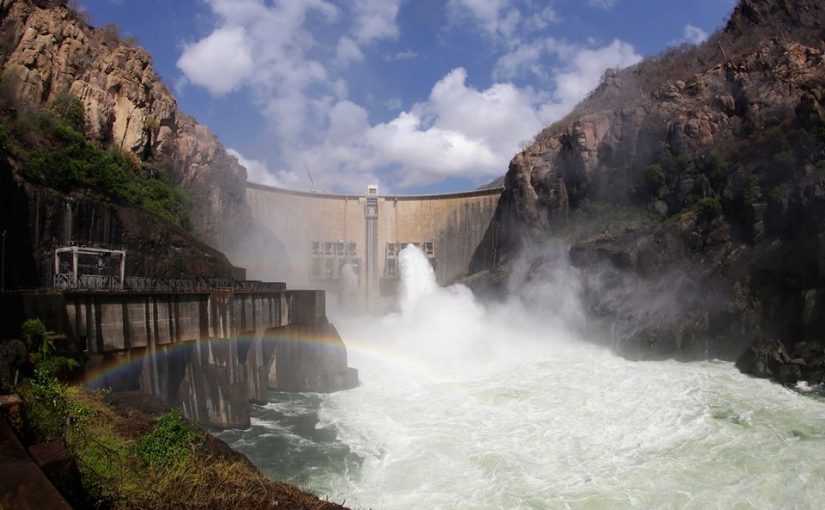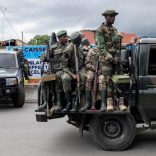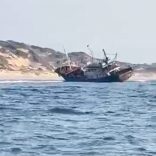Congo, M23 delegations leave Doha as peace talks stall - sources
Wet coal (five years ago) and Cahora Bassa: here are all the reasons Eskom has volunteered for load shedding since 2014

Photo; HCB
- Eskom has used a wide range of explanations for load shedding over the last five years, including weather (both hot and cold), a strike, and Medupi.
- “Wet coal” is an excuse at least five years old – but was not prominent in the days leading up to this week’s stage 6 load shedding.
- Here are all the major excuses Eskom has offered for load shedding since February 2014.
Imports from Mozambique’s Cahora Bassa hydropower scheme has been a culprit a couple of times. So has winter weather (and, nearly, summer weather), the need to plan for the week, failure to plan for the week, and striking workers.
Over the past five years Eskom has volunteered all of these, and more, as the reasons behind various levels of electricity rationing.
The excuses and explanations provide a glimpse into the changing strategy – both in managing creaking infrastructure to keep on the lights and in communicating with angry residents left in the dark – behind the scenes.
They also show how little things have changed in half a decade.
Here are the excuses Eskom has volunteered for implementing load shedding over the past five years.
‘Reduced imports’ – February 2014
Eskom didn’t actually implement rationing in February 2014, instead it just declared an emergency and asked everyone to reduce their usage, including major industrial customers. The crisis was at least in part due to local generators being out of service, but trouble with the feed from Mozambique’s Cahora Bassa hydropower scheme also played a role. That power came into SA via a long transmission line through some tough, and politically volatile, territory hit by occasional nasty weather – which some might say makes breakdowns to be expected.
‘Wet coal’ – March 2014
On 6 March 2014 Eskom turned off the lights for the first time since 2008 through rotational load shedding, with a full day of rationing from 8AM to 10PM.
The next day CEO Brian Dames made a presentation running to 43 slides explaining just what had gone wrong, and what the company was doing about it.
On top of the usual outages due to breakdowns and maintenance was “wet coal”. Eight days of rain in Mpumalanga had caused trouble with handling and feeding coal into boilers, Dames said.
The weekend is better than the week – late November 2014
In late November 2014 Eskom implemented stage 2 load shedding over a weekend not because of a shortage of capacity, but because it thought there would be a shortage later. Turning off the power on a Saturday and Sunday would allow it to pump water and save on diesel, and so reduce the odds of load shedding the following Monday and Tuesday.
… but we can’t make it through the week either – early December 2014
By the Thursday following that weekend of preparatory load shedding, power was turned off again between 4PM and 10PM, in part because of “logistical issues relating to diesel supplies” at the giant generators Eskom uses to meet peak demand.
By the Friday diesel had entirely run out at those peaking plants, and load shedding was shifted into higher gear, and continued throughout the weekend as Eskom again said it had to build up reserves for the week ahead.
You are using too much electricity – early January 2015
By the start of 2015 there had been a subtle shift in the way Eskom presented news of load shedding. It kept acknowledging that the “unavailability” of units at power stations was not ideal – but foregrounded “high electricity demand” as the reason for rationing.
It simultaneously ramped up calls for consumers to literally turn off lights to help stabilise the grid.
The calls to save on power would continue, but what seemed like at least sub-conscious blame-shifting did not last long.
‘[un]foreseen technical problems’ – late January 2015
Instead, Eskom went terse. In announcing load shedding on 26 January 2015 the reason the utility presented was, in full: “unforeseen technical problems”.
Seven hours later it added “system constraints” to that explanation. The next day it said the problem was a “shortage of generation capacity”.
The week is better than the weekend – very late January 2015
In December 2014 Eskom said it would prioritise load shedding on the weekends to lessen the economic impact of its rationing. Then, right at the end of January 2015, it explained that it was implementing load shedding throughout the week to prevent severe load shedding later in the week.
During the last set of blackouts that month Eskom said it has spent the water in pumped storage schemes to keep the lights on during the weekend, so had to turn the lights off during the week.
For all these highly-detailed technical reasons – February 2015
As it flipped electricity on and off for much of February, Eskom mostly provided little explanation for its actions – except when it provided a great amount of detail on occasion.
On 4 February 2015, for instance, Eskom explained that its Majuba power station had an ash conveyer belt stuck on its unit 3, while the Duvha plant had experienced a trip on its unit 2, while Koeberg’s unti 1 was out due to an earth fault on its generator transformer.
Two days later it provided even more detail, saying that the Koeberg trouble had all started with a scaffold touched the neutral earthing bar above the restricted earth circuit.
Taking South Africa into its confidence to that extent did not develop into a habit, however. Quite the opposite.
We have to prepare for winter – March and April 2015
For the next two months Eskom repeated one phrase again and again: “planned and unplanned outages”. Every time it announced rationing, that phrase, or a close variant, was provided as reason.
Some units were dropping out of production requiring due to faults, Eskom said, but it also had to implement an aggressive schedule of planned maintenance to prepare for the coming winter, and the higher demand the grid would face as people turned on heaters.
Winter is here – May and early June 2015
That May winter started to arrive – and so did power outages. Load shedding was necessary because of “cooler weather conditions”, Eskom said at first, then because of “continued cold weather”.
It is cloudy – mid June 2015
Towards the middle of June Eskom went through one of its rare bouts of more detailed explanations, saying – though it did not provide technical information on how – that it has lost 600MW from the Duvha power station and 300MW from Mozambique’s Cahora Bassa – plus another 300MW it had expected from solar farms in the Northern Cape, where cloudy weather had unexpectedly set in.
It’s cold – July and August 2015
For the remainder of the winter of 2015 there were no further explanations around load shedding, just a standard “it’s pretty cold” from Eskom.
In September that year the company warned that, as the weather warms up, “usage of electricity becomes high for most of the day, predominantly due to the increased usage of air-conditioners, geysers and pool pumps.” But it managed to withstand that new seasonal demand and did not implement forced blackouts for the rest of that summer, and some time after.
Striking workers – June and July 2018
When load shedding returned with a bang in the winter of 2018, Eskom said it was “due to the impact of the current illegal protest action by some Eskom employees at various sites over wage increases”.
It did not specify whether workers had actively sabotaged stations or the grid, had intimidated non-strikers, or had merely walked away and let machines grind to a halt.
No reason to Mozambique again – November and December 2018
In announcing rationing in November last year, Eskom initially provided no reason, no reference to weather or outages or preparations. It said only it was turning off power to some customers to “preserve emergency resources”.
It later went back to that old favourite, “maintenance and unplanned outages”, before stepping it up one more notch before the end of that month, saying it was trouble with the Cahora Bassa supply again.
Medupi and Kusile, and we’re fixing it – February 2019
January this year provided a short reprieve from load shedding, but by 10 February the blackouts were back. Eskom stuck to a mixture of generic – and previously tested – explanations: shortage of generating capacity, and the “need to replenish and preserve emergency water and diesel resources to limit load shedding possibility or magnitude thereof in the following week”.
After a 6-hour meeting between the Eskom board, management, and public enterprises minister Pravin Gordhan, there were some more details – and two new culprits.
“The Medupi and Kusile power stations – the core of the new build programme – are continuing to show a lack of reliability to contribute meaningfully to Eskom’s generating capacity, which is a serious concern,” Eskom said in a statement.
“The Board has resolved to institute an urgent review to establish when, realistically, these projects will be completed, the extent of design- and other operational faults, what steps can be implemented to minimise the ever-escalating costs and what can be done to increase output.
Hey look, it’s Mozambique again – March 2019
For much of March the explanations from Eskom were a mixture of unspecified generating capacity lost and the need to shore up reserves of water and diesel. In the middle of the month, however, electricity imports from Mozambique were lost again due to a cyclone, and that became the cited reason for stage 4 load shedding.
Medupi isn’t working, pretty much at all – October 2019
In mid-October load shedding was again blamed on unexpected breakdowns that, it appeared, were spread throughout Eskom’s fleet. But it soon became apparent that Medupi was a primary culprit.
In one night, Eskom said, it lost the output of units 3, 4, and 5 at Medupi “due to coal and ash handling issues”. This was on top of a conveyer belt at Medupi that had failed earlier.
There was no mention of rain.
‘Generating units’ lost – November 2019
Outages in November were blamed on unit outages, at power stations not specified.
The usual, no, wait, there goes Medupi. Also, floods – December 2019
Late on 9 December, Eskom now famously declared a power emergency requiring an unprecedented stage 6 load shedding. But in the run-up to that event the explanations volunteered for load shedding were nearly identical to those that had been offered in previous months and years. And after that brief period of stage 6 rationing, the explanations again subsided into the usual pattern.
Here’s how December’s announcements played out.
5 December (4PM): “high levels of unplanned breakdowns”.
5 December (11PM): “further unplanned breakdowns, critically low water levels at our pumped storage schemes and the need to manage diesel reserves”.
6 December (1PM): More unspecified generating units lost, and “units not having returned to service as scheduled”.
6 December (9PM): “to cater for further trips and to create capacity to replenish water reserves for our pumped storage schemes”.
7 December (10AM): “generating units still out of service due to breakdowns” – and not the rain. “There is also an improvement in managing coal handling with regard to wet coal, with only one station experiencing coal-handling problems, as a result of the incessant rains,” Eskom said.
7 December (9PM): “to cater for further trips and to create capacity to replenish water reserves for our pumped storage schemes” – and build up reserves so shedding could be limited during the week.
8 December (8AM): “to cater for further trips and to create capacity to replenish water reserves for our pumped storage schemes”.
8 December (8PM): “to cater for further trips and to create capacity to replenish water reserves for our pumped storage schemes” – and build up capacity to limit load shedding during the week.
9 December (8AM): “With the incessant rains we are beginning to experience flooding at some power stations, which is impacting coal handling and operations which could further lead to capacity load losses and impact supply as the rainy weather persists.”
9 December (8PM) – as load shedding hits stage 6: A loss of power to the conveyors feeding coal to the silos at Medupi; flooding at both Kriel power station and its accompanying mine, and high rainfall at Camden power station ” leading to flooding impacting the boiler and turbine hall and other critical infrastructure that is connected to coal supply and handling inside the station”.
10 December (10AM): “The incessant rains continue to impact coal handling and operations at our power stations.”
10 December (11PM): “to manage our emergency diesel and pumped storage reserves”.
11 December (7AM): “as a result of a shortage of capacity”.
By Phillip de Wet













Leave a Reply
Be the First to Comment!
You must be logged in to post a comment.
You must be logged in to post a comment.